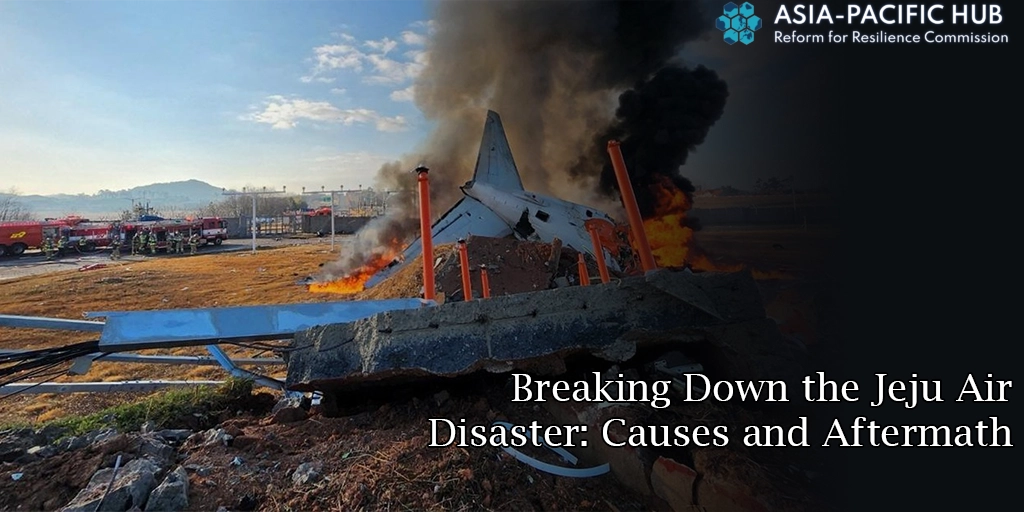
Breaking Down the Jeju Air Disaster: Causes and Aftermath
Resilience APAC – South Korea was left in shock as a Jeju Air flight veered off the runway at Muan International Airport, resulting in the deaths of at least 167 passengers and crew. This tragic incident has become one of the deadliest aviation disasters in South Korean history. As investigations continue, initial reports suggest that a bird strike may have played a role in the catastrophic event.
The Jeju Air flight, which departed from Bangkok, Thailand, was approaching Muan International Airport when disaster struck. As the plane attempted to land, it veered off the runway, crashing into a perimeter wall. The impact caused significant structural damage and ignited a fire, leading to the devastating loss of life. Emergency responders were quick to arrive, but the severity of the crash left little room for survivors.
Out of the 181 people on board, at least 167 have been confirmed dead. The victims include 54 men and 57 women, while 13 bodies remain unidentifiable. Two passengers miraculously survived, and rescue operations continue as authorities sift through the wreckage.
READ MORE :ABGX: A Modern Solution for Radiation Protection Management
In response to the tragedy, South Korea mobilized a massive emergency effort. Over 1,500 personnel were dispatched to the scene, including:
Rescue teams worked tirelessly to manage the fire, recover bodies, and search for potential survivors. The operation remains ongoing as officials work to clear the site and conduct further investigations.
While the exact cause of the accident remains under investigation, preliminary reports indicate that a bird strike may have caused the landing gear to malfunction. This potential failure prevented the aircraft from stopping on the runway, leading to the collision. Aviation experts are conducting detailed analyses of flight data and black box recordings to confirm the theory.
Bird strikes are not uncommon in aviation, but such incidents rarely result in tragedies of this scale. The crash has reignited discussions on runway safety protocols and the need for enhanced wildlife management around airports.
South Korean Acting President Choi Sang-mok declared Muan a special disaster zone, ensuring that resources and aid are directed to the affected families. In an official statement, Choi extended his condolences and reassured the public that the government is committed to supporting the victims’ loved ones.
The tragedy has prompted a nationwide period of mourning, with memorial services being held across the country. Many have expressed shock and disbelief, as Jeju Air had previously enjoyed a strong safety record since its founding in 2005.
This disaster marks the first fatal incident in Jeju Air’s nearly two-decade history. As South Korea’s largest low-cost carrier, Jeju Air has been a key player in regional travel, offering affordable flights to numerous destinations across Asia. The airline’s leadership has publicly apologized, pledging full cooperation with investigators and reinforcing their commitment to passenger safety.
Despite the tragedy, South Korea’s aviation industry is widely regarded as having high safety standards. This incident is a rare occurrence in an otherwise solid track record for the country’s airlines.
If the death toll continues to rise, this crash could surpass the Air China disaster of 2002, which claimed 129 lives, making it the deadliest aviation accident in South Korea’s history. The last major incident involving a South Korean carrier occurred in 2013 when an Asiana Airlines flight crashed in San Francisco, resulting in three fatalities.
The Jeju Air disaster at Muan International Airport stands as a grim reminder of the unpredictable nature of air travel. As families mourn and investigations press forward, the nation is left reflecting on the importance of stringent aviation safety measures. Moving ahead, South Korea’s aviation authorities are expected to implement new strategies to enhance runway safety and prevent future tragedies. Our thoughts remain with the victims and their families during this difficult time.
Resilienceapac - Economic momentum in China has once again captured global attention as the country reported a 5.2% year-on-year GDP…
Resilienceapac - White Coats in Revolt has become the defining phrase of South Korea’s current healthcare crisis. Since late 2024,…
Resilienceapac - Climate Crisis Unleashed is becoming more visible and devastating in South Asia, where monsoon rains are no longer…
Resilienceapac - Acer rises to the top as one of the standout performers in the Asia Pacific technology landscape. In…
Resilienceapac - Huawei Eyes Southeast Asia in a strategic push to expand its artificial intelligence (AI) chip business, aiming to…
Resilienceapac - Papua New Guinea marked 50 years of independence on September 16, 2025, a moment both celebratory and sobering.…